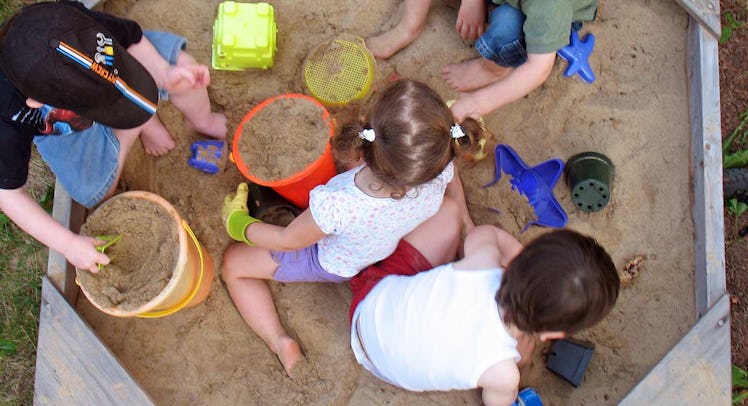10 Steps To The Backyard Sandbox Of Your Kid’s Dreams
Lumber. Screwing. Holes. What more do you need?

In a perfect world, you would send your kid out to play by simply shoving them into the yard with a pat on the back and a stoic “good luck.” From there, they would make their own way to adventure like some less-racist 3-year-old Huck Finn. You know, minus the thieving and brawling.
But “kids these days” need stuff in the yard to occupy them, like play structures with climbing walls, swings and sandboxes. Luckily for you, you can build that last one yourself really simply, and under $200. You probably don’t even need any Twaining.
Sand Boxing
The resourceful cats over at This Old House have you covered for your sandbox building needs. They’ve put together a semi-below ground option that is light on materials and completable within an afternoon of solid labor. Aside from some lumber and landscaping fabric, all you need is the ability to dig a hole, drive screws and use a framing square. Holes? Lumber? Fabric? Screwing? It’s okay. Take a moment to collect yourself before you get started.
Materials
- 12 lengths of 4×4 that combine to create a 3-course-high border
- Enough landscaping fabric to completely cover the area of the sandbox
- Big bag of decking screws
- Natural play sand
Before Getting Started
Note that the size of your sandbox is up to you. But when you lay out the border, the 4x4s will go end-to-side. So however big you want the sides of your border to be, make sure you trim the ends by 3 and a half inches. Because 4×4’s are lying to you. Their true width is 3 and a half inches. But, everybody lies about size, right?
The Steps
Now that you’ve got your tools handy, your wood cut, and your kid ready to do some light labor, it’s time to build.
- Lay out the perimeter of the box. Preferably on a flat spot in your yard.
- Dig out the interior of the box. Go 6 inches deep. Include the dirt under the wood you laid out.
- Add a 1-inch deep and 4-inch wide layer of sand around the perimeter.
- Lay your 4×4 border on top of the sand. Make side the lumber runs end-to-side.
- Using a framing square, perfectly square up the whole shebang and secure with decking screws.
- Lay your next course of lumber on top, the corners should have the opposite end-to-side configuration than the one below it.
- Secure the second course with decking screws every 3 feet.
- Add the landscaping fabric by covering the entire hole and tucking it into the corners. It should overlap the second course of lumber around the perimeter.
- Add the third and final course of lumber, securing it every 3 feet before trimming excess landscaping fabric.
- Fill with sand and tidy up.
The Sand
So there’s this controversy out there in the world that play sand might, in fact, be carcinogenic. That’s supposedly due in part to the fine silica dust which comes as a byproduct of the sand making process. Now this can be a risk with prolonged dust inhalation, but it is slight (unless your kid works a 40 hour week as a sandblaster).
If it does make you nervous, there are silica-free play sand alternatives that you won’t find in 50-pound bags at your nearest depot of home. Obviously, they’ll cost you. But you can snag the options like Sandtastik sand or Safe Sand from Amazon.
Sandbox Tips
To keep that pesky dust down, go ahead and keep the sand slightly damp during the months it’s in use. Also, make sure it’s covered to keep out animal poop. Finally, make sure all the wood and stains you use are as non-toxic as possible, and make sure to provide some shade, because as you know sand can get way hot.
In the end, going through the whole (hole?) sandbox process should be simple and kid-friendly. Be sure to check out the video on This Old House to get all of the details (including how to keep the animals out). Then get to building that sandcastle and pretending you’re A Yankee In King Arthur’s Court.
This article was originally published on